Question
The table below shows the number of words in the extended essays of an IB class.

Draw a histogram on the grid below for the data in this table.
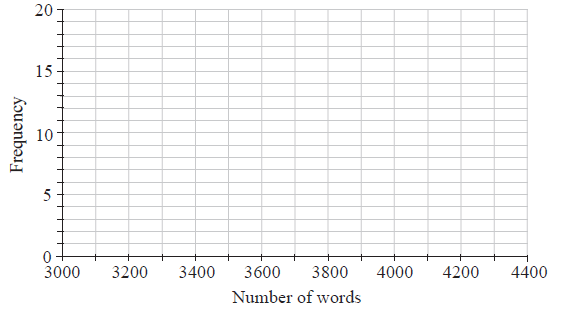 [3]
[3]
Write down the modal group.[1]
The maximum word count is \(4000\) words.
Write down the probability that a student chosen at random is on or over the word count.[2]
Answer/Explanation
Markscheme
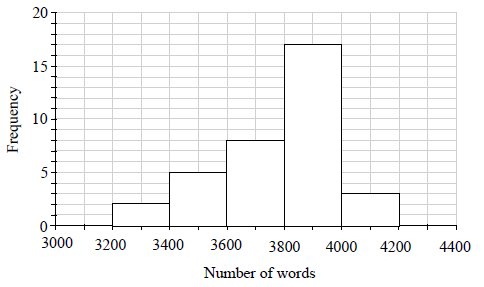 (A3) (C3)
(A3) (C3)
Notes: (A3) for correct histogram, (A2) for one error, (A1) for two errors, (A0) for more than two errors.
Award maximum (A2) if lines do not appear to be drawn with a ruler.
Award maximum (A2) if a frequency polygon is drawn.[3 marks]
\({\text{Modal group}} = 3800 \leqslant w < 4000\) (A1) (C1)[1 mark]
\({\text{Probability}} = \frac{3}{{35}}{\text{ }}(0.0857{\text{, }}8.57\% )\) (A1)(A1) (C2)
Note: (A1) for correct numerator (A1) for correct denominator.[2 marks]
Question
The following histogram shows the weights of a number of frozen chickens in a supermarket. The weights are grouped such that \(1 \leqslant {\text{weight}} < 2\), \(2 \leqslant {\text{weight}} < 3\) and so on.
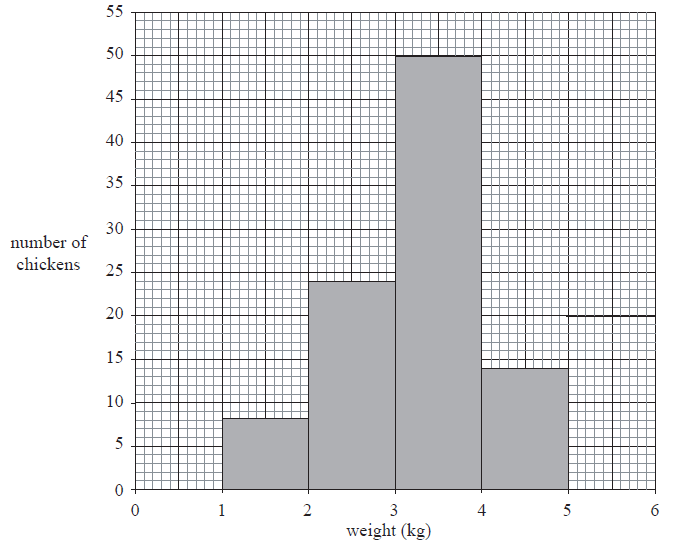
Find the total number of chickens.[1]
Write down the modal group.[1]
Gabriel chooses a chicken at random.
Find the probability that this chicken weighs less than \(4{\text{ kg}}\).[2]
Answer/Explanation
Markscheme
\(96\) (A1) (C1)[1 mark]
\(3 \leqslant {\text{weight}} < 4{\text{ kg}}\) . Accept \(3 – 4{\text{ kg}}\) (A1) (C1)[1 mark]
For adding three heights or subtracting \(14\) from \(96\) (M1)
\(\frac{{82}}{{96}}{\text{ }}(0.854{\text{ or }}\frac{{41}}{{48}}{\text{, }}85.4\% )\) (ft) from (b). (A1)(ft) (C2)[2 marks]
Question
A fair six-sided die has the numbers 1, 2, 3, 4, 5, 6 written on its faces. A fair four-sided die has the numbers 1, 2, 3, and 4 written on its faces. The two dice are rolled.
The following diagram shows the possible outcomes.
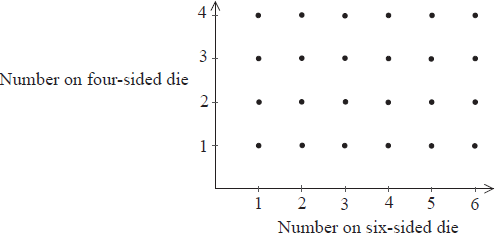
Find the probability that the two dice show the same number.[2]
Find the probability that the difference between the two numbers shown on the dice is 1.[2]
Find the probability that the number shown on the four-sided die is greater than the number shown on the six-sided die, given that the difference between the two numbers is 1.[2]
Answer/Explanation
Markscheme
\(\frac{4}{{24}}\) \(\left( {\frac{1}{6},0.167,16.7{\text{ }}\% } \right)\) (A1)(A1) (C2)
Note: Award (A1) for numerator, (A1) for denominator.[2 marks]
\(\frac{{7}}{{24}}\) \((0.292,29.2{\text{ }}\% )\) (A1)(A1)(ft) (C2)
Note: Award (A1)(ft) from the denominator used in (a).[2 marks]
\(\frac{{3}}{{7}}\) \((0.429,42.9{\text{ }}\% )\) (A1)(A1)(ft) (C2)
Note: Award (A1) for numerator (A1)(ft) for denominator, (ft) from their numerator in (b).[2 marks]
Question
A weighted die has 2 red faces, 3 green faces and 1 black face. When the die is thrown, the black face is three times as likely to appear on top as one of the other five faces. The other five faces have equal probability of appearing on top.
The following table gives the probabilities.

Find the value of
(i) m;
(ii) n.[2]
The die is thrown once.
Given that the face on top is not red, find the probability that it is black.[2]
The die is now thrown twice.
Calculate the probability that black appears on top both times.[2]
Answer/Explanation
Markscheme
(i) m = 1 (A1)
(ii) n = 3 (A1) (C2)
Note: Award (A0)(A1)(ft) for \(m = \frac{1}{8}, n = \frac{3}{8}\).
Award (A0)(A1)(ft) for m = 3, n = 1.[2 marks]
\({\rm{P}}(B/R’) = \frac{{\frac{3}{8}}}{{\frac{6}{8}}} = \frac{3}{6}\left( {\frac{1}{2},50\% ,0.5} \right)\) (M1)(A1)(ft) (C2)
Note: Award (M1) for correctly substituted conditional probability formula or for 6 seen as part of denominator.[2 marks]
\({\rm{P}}(B,B) = \frac{3}{8} \times \frac{3}{8} = \frac{9}{{64}}(0.141)\) (M1)(A1)(ft) (C2)
Note: Award (M1) for product of two correct fractions, decimals or percentages.
(ft) from their answer to part (a) (ii).[2 marks]
Question
A bag contains 7 red discs and 4 blue discs. Ju Shen chooses a disc at random from the bag and removes it. Ramón then chooses a disc from those left in the bag.
Write down the probability that
(i) Ju Shen chooses a red disc from the bag;
(ii) Ramón chooses a blue disc from the bag, given that Ju Shen has chosen a red disc;
(iii) Ju Shen chooses a red disc and Ramón chooses a blue disc from the bag.[3]
Find the probability that Ju Shen and Ramón choose different coloured discs from the bag.[3]
Answer/Explanation
Markscheme
(i) \(\frac{7}{{11}}\) (\(0.636\), \(63.6\% \)) (\(0.636363 \ldots \)) (A1) (C1)
(ii) \(\frac{4}{{10}}\) \(\left( {\frac{2}{5}{\text{, }}0.4{\text{, }}40\% } \right)\) (A1) (C1)
(iii) \(\frac{{28}}{{110}}\) \(\left( {\frac{{14}}{{55}}{\text{, }}0.255{\text{, }}25.5\% } \right)\) \(0.254545 \ldots \) (A1)(ft) (C1)
Note: Follow through from the product of their answers to parts (a) (i) and (ii).[3 marks]
\(\frac{{28}}{{110}} + \left( {\frac{4}{{11}} \times \frac{7}{{10}}} \right)\) OR \(2 \times \frac{{28}}{{110}}\) (M1)(M1)
Notes: Award (M1) for using their \(\frac{{28}}{{110}}\) as part of a combined probability expression. (M1) for either adding \({\frac{4}{{11}} \times \frac{7}{{10}}}\) or for multiplying by 2.
\( = \frac{{56}}{{110}}\) \(\left( {\frac{{28}}{{55}}{\text{, }}0.509{\text{, }}50.9\% } \right)\) (\(0.509090 \ldots \)) (A1)(ft) (C3)
Note: Follow through applies from their answer to part (a) (iii) and only when their answer is between 0 and 1.[3 marks]
Question
Alan’s laundry basket contains two green, three red and seven black socks. He selects one sock from the laundry basket at random.
Write down the probability that the sock is red.[1]
Alan returns the sock to the laundry basket and selects two socks at random.
Find the probability that the first sock he selects is green and the second sock is black.[2]
Alan returns the socks to the laundry basket and again selects two socks at random.
Find the probability that he selects two socks of the same colour.[3]
Answer/Explanation
Markscheme
\(\frac{3}{{12}}\left( {\frac{1}{4},0.25,25\% } \right)\) (A1) (C1)
\(\left( {\frac{2}{{12}}} \right) \times \left( {\frac{7}{{11}}} \right)\) (M1)
Note: Award (M1) for correct product.
\( = \frac{{14}}{{132}}\left( {\frac{7}{{66}},0.10606…,10.6\% } \right)\) (A1) (C2)
\(\left( {\frac{2}{{12}} \times \frac{1}{{11}}} \right) + \left( {\frac{3}{{12}} \times \frac{2}{{11}}} \right) + \left( {\frac{7}{{12}} \times \frac{6}{{11}}} \right)\) (M1)(M1)
Note: Award (M1) for addition of their 3 products, (M1) for 3 correct products.
\( = \frac{{50}}{{132}}\left( {\frac{25}{{66}},0.37878…,37.9\% } \right)\) (A1) (C3)
Question
The IB grades attained by a group of students are listed as follows.
\[{\text{6}}\;\;\;{\text{4}}\;\;\;{\text{5}}\;\;\;{\text{3}}\;\;\;{\text{7}}\;\;\;{\text{3}}\;\;\;{\text{5}}\;\;\;{\text{4}}\;\;\;{\text{2}}\;\;\;{\text{5}}\]
Find the median grade.[2]
Calculate the interquartile range.[2]
Find the probability that a student chosen at random from the group scored at least a grade \(4\).[2]
Answer/Explanation
Markscheme
\(2\;\;\;3\;\;\;3\;\;\;4\;\;\;4\;\;\;5\;\;\;5\;\;\;5\;\;\;6\;\;\;7\) (M1)
Note: Award (M1) for correct ordered set.
\(({\text{Median}} = ){\text{ }}4.5\) (A1) (C2)
\(5 – 3\) (M1)
Note: Award (M1) for correct quartiles seen.
\( = 2\) (A1) (C2)
\(\frac{7}{{10}}\;\;\;(0.7,{\text{ }}70\% )\) (A2) (C2)
Question
Peter either walks or cycles to work. The probability that he walks is 0.25. If Peter walks to work, the probability that he is late is 0.1. If he cycles to work, the probability that he is late is 0.05. The tree diagram for this information is shown.
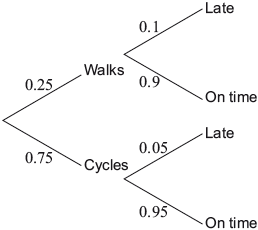
On a day chosen at random, Peter walked to work.
Write down the probability that he was on time.[1]
For a different day, also chosen at random,
find the probability that Peter cycled to work and was late.[2]
For a different day, also chosen at random,
find the probability that, given Peter was late, he cycled to work.[3]
Answer/Explanation
Markscheme
\(0.9\) (A1) (C1)
\(0.75 \times 0.05\) (M1)
\( = 0.0375\;\;\;\left( {\frac{3}{{80}},{\text{ 3,75% }}} \right)\) (A1) (C2)
\(\frac{{0.75 \times 0.05}}{{0.75 \times 0.05 + 0.25 \times 0.1}}\) (M1)(M1)
Note: Award (M1) for their correct numerator, (M1) for their correct denominator, ie, \(\left( {\frac{{{\text{their (b)}}}}{{{\text{their (b)}} + 0.25 \times 0.1}}} \right)\).
Do not award (M1) for their \(0.0375\) or \(0.0625\) if not a correct part of a fraction.
\( = 0.6\;\;\;\left( {\frac{3}{5},{\text{ }}60\% } \right)\) (A1)(ft) (C3)
Note: Follow through from part (b).
Question
The probability that Nikita wins a tennis match depends on the surface of the tennis court on which she is playing. The probability that she plays on a grass court is \(0.4\). The probability that Nikita wins on a grass court is \(0.35\). The probability that Nikita wins when the court is not grass is \(0.25\).
Complete the following tree diagram.
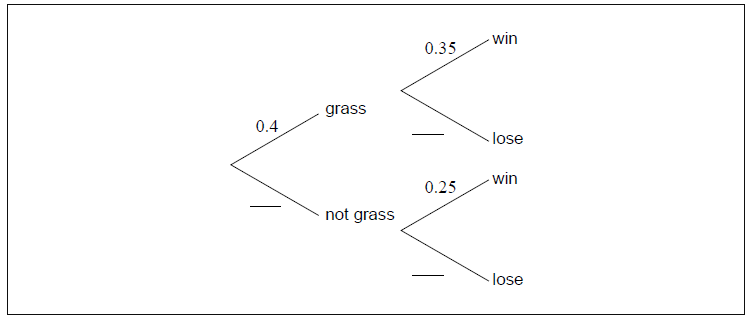
Find the probability that Nikita wins a match.[3]
Answer/Explanation
Markscheme
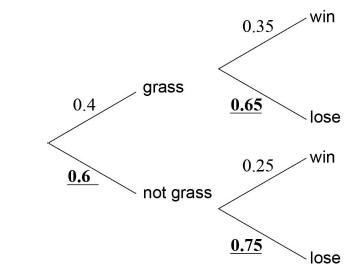 (A1)(A1)(A1) (C3)
(A1)(A1)(A1) (C3)
Note: Award (A1) for each correct entry.[3 marks]
\(0.4 \times 0.35 + 0.6 \times 0.25\) (A1)(ft)(M1)
Note: Award (A1)(ft) for two correct products from their tree diagram seen, and (M1) for the addition of their products.
\( = 0.29\) (A1)(ft) (C3)
Note: Follow through from part (a).[3 marks]
Question
Two friends, Sensen and Cruz, are conducting an investigation on probability.
Sensen has a fair six-sided die with faces numbered \(1,\,\,2,\,\,2,\,\,4,\,\,4\) and \(4\). Cruz has a fair disc with one red side and one blue side.
The die and the disc are thrown at the same time.
Find the probability that the number shown on the die is \(1\) and the colour shown on the disc is blue;[2]
Find the probability that the number shown on the die is \(1\) or the colour shown on the disc is blue;[2]
Find the probability that the number shown on the die is even given that the colour shown on the disc is red.[2]
Answer/Explanation
Markscheme
\(\frac{1}{2} \times \frac{1}{6}\) (M1)
\(\frac{1}{{12}}\,\,(0.0833,\,\,8.33\,\% ,\,\,0.08333…)\) (A1) (C2)
\(\frac{1}{2} + \left( {\frac{1}{2} \times \frac{1}{6}} \right)\) (M1)
OR
\(\frac{1}{6} + \frac{1}{2} – \frac{1}{{12}}\,\) (M1)
\(\frac{7}{{12}}\,\,(0.583,\,\,58.3\,\% ,\,\,0.58333…)\) (A1) (C2)
Note: Award (M1)(A0) for a correct attempt at a possibility/sample space diagram or tree diagram or \(\frac{1}{6} + \left( {\frac{5}{6} \times \frac{1}{2}} \right)\), leading to an incorrect answer.
\(\frac{1}{3} + \frac{1}{2}\) (M1)
OR
\(\frac{{\frac{5}{6} \times \frac{1}{2}}}{{\frac{1}{2}}}\) (M1)
\(\frac{5}{6}\,\,(0.833,\,\,83.3\,\% ,\,\,0.83333…)\) (A1) (C2)
Notes: Award (M1)(A0) for a correct attempt at a possibility/sample space diagram or tree diagram, leading to an incorrect answer.
Question
Rosewood College has 120 students. The students can join the sports club (\(S\)) and the music club (\(M\)).
For a student chosen at random from these 120, the probability that they joined both clubs is \(\frac{1}{4}\) and the probability that they joined the music club is\(\frac{1}{3}\).
There are 20 students that did not join either club.
Complete the Venn diagram for these students.
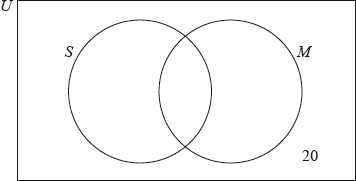 [2]
[2]
One of the students who joined the sports club is chosen at random. Find the probability that this student joined both clubs.[2]
Determine whether the events \(S\) and \(M\) are independent.[2]
Answer/Explanation
Markscheme
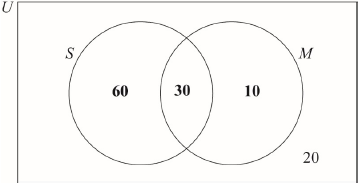 (A1)(A1) (C2)
(A1)(A1) (C2)
Note: Award (A1) for 30 in correct area, (A1) for 60 and 10 in the correct areas.[2 marks]
\(\frac{{30}}{{90}}{\text{ }}\left( {\frac{1}{3},{\text{ }}0.333333 \ldots ,{\text{ }}33.3333 \ldots \% } \right)\) (A1)(ft)(A1)(ft) (C2)
Note: Award (A1)(ft) for correct numerator of 30, (A1)(ft) for correct denominator of 90. Follow through from their Venn diagram.[2 marks]
\({\text{P}}(S) \times {\text{P}}(M) = \frac{3}{4} \times \frac{1}{3} = \frac{1}{4}\) (R1)
Note: Award (R1) for multiplying their by \(\frac{1}{3}\).
therefore the events are independent \(\left( {{\text{as P}}(S \cap M) = \frac{1}{4}} \right)\) (A1)(ft) (C2)
Note: Award (R1)(A1)(ft) for an answer which is consistent with their Venn diagram.
Do not award (R0)(A1)(ft).
Do not award final (A1) if \({\text{P}}(S) \times {\text{P}}(M)\) is not calculated. Follow through from part (a).[2 marks]
Question
In an international competition, participants can answer questions in only one of the three following languages: Portuguese, Mandarin or Hindi. 80 participants took part in the competition. The number of participants answering in Portuguese, Mandarin or Hindi is shown in the table.

A boy is chosen at random.
State the number of boys who answered questions in Portuguese.[1]
Find the probability that the boy answered questions in Hindi.[2]
Two girls are selected at random.
Calculate the probability that one girl answered questions in Mandarin and the other answered questions in Hindi.[3]
Answer/Explanation
Markscheme
20 (A1) (C1)[1 mark]
\(\frac{5}{{43}}\,\,\,\left( {0.11627 \ldots ,\,\,11.6279 \ldots {\text{% }}} \right)\) (A1)(A1) (C2)
Note: Award (A1) for correct numerator, (A1) for correct denominator.[2 marks]
\(\frac{7}{{37}} \times \frac{{12}}{{36}} + \frac{{12}}{{37}} \times \frac{7}{{36}}\) (A1)(M1)
Note: Award (A1) for first or second correct product seen, (M1) for adding their two products or for multiplying their product by two.
\( = \frac{{14}}{{111}}\,\,\left( {\,0.12612 \ldots ,\,\,12.6126\,{\text{% }}} \right)\) (A1) (C3)[3 marks]
